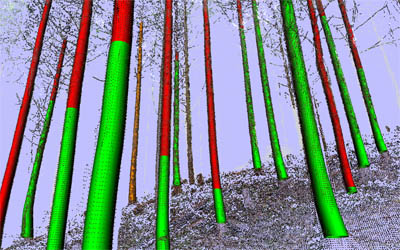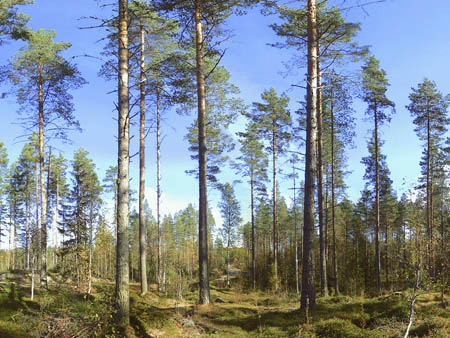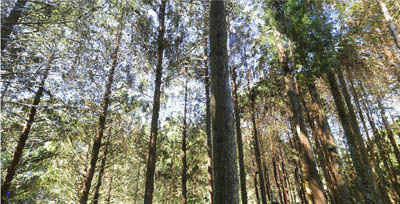A TreeMetrics 3D photo scanner - it helps foresters determine width, height, volume of trees, as well as wood quality
They’ve been around since 2005, but the Enterprise Ireland-supported Irish clean-tech firm TreeMetrics, led by two young former foresters (Enda Keane and Garret Mullooly) also supported by IBM and Coillte, is now ready to tell its story about how it is aiming to revolutionise the forestry industry, making it cleaner, more CO2-friendly, and ultimately helping foresters increase their bottom line, while protecting the environment as best they can. The company is also doubling its workforce to 20 in the next few months.
TreeMetrics has pioneered a unique cloud-based platform that also harnesses Google Earth, to bring foresters into the digital century using cloud computing. It has recently secured contracts with some of the planet’s most prominent state forest owners, including the British Forestry Commission, Forestry South Australia and the state forest owner in Finland – Metsahallitus.
Just this morning, TreeMetrics won a “major” international contract that it had been working on for months, but the company is not at liberty to disclose the name of the forest owner until next week. Speaking this morning from Scotland, the two co-founders said that the secured tender is a “massive win” for TreeMetrics.
Here in Ireland, our very own Coillte has supported the company’s vision, awarding TreeMetrics its first contract to map forests on the island.
The self-starters behind TreeMetrics – Enda Keane and Garret Mullooly – say they developed their tech solution ‘by foresters for foresters”.
“It’s achievable to cut down less trees than we cut down today, while still meeting up to the needs of planet Earth’s increasing demand for wood. We need to have more knowledge about forests, and the type of trees in them, before we can cut.”
Since they set up shop in 2005, co-founders Keane (also CEO) and Mullooly (also COO), have been busy working behind the scenes in some of the world’s most spectacular forests by pioneering 3D forestry mapping technology. For instance, the duo have been successfully testing their technologies in forests around the world, from Finland to Uruguay to South Australia.
Based at the Rubicon Centre at Cork Institute of Technology, TreeMetrics is really one to watch right now, as it’s aiming to transform how foresters map forests, helping them to have foresight into how many trees they can cut down, as well as determining the quality of them, before selling them to companies and agreeing on prices – all by using the software created by TreeMetrics, as well as the Google Earth platform.
The company is aiming to achieve its vision of becoming the data warehouse for forestry and for forestry knowledge, with its data being kept in-house in Cork, Ireland, supporting the local economy and with the positive spin-off being the creation of green collar jobs. Incidentally, TreeMetrics is set to double its workforce from 10 to 20 in the next few months.
3D mapping technology for foresters, created by foresters (TreeMetrics)

The 3D mapping technology pioneered by Irish start-up TreeMetrics will aim to revolutionise the future of forestry mapping
Evolution
So how did TreeMetrics get off the ground?
Mullooly and Keane first met in the Ag Science building at University College Dublin in 1993, when they were both fresh, eager students starting to study forestry there.
It was to be the genesis of a very fruitful partnership that would lead the two of them to pool their respective business, forestry and IT talents together to go out on their own in 2005 and co-found a new company called TreeMetrics.
Straight away, they set their sights high, and started to approach entities such as Enterprise Ireland, Coillte, Teagasc and forest commissions in Finland, for instance, to glean their expertise, both on funding and on what the various entities thought of their 3D forestry mapping idea.
But, weren’t they afraid that their idea might be stolen, before they had patented their technology?
“Not at all!” say Keane and Mullooly. “The secret is to be open and to communicate with as many stakeholders as possible. You need their help and you must be transparent when you are a start-up.
“And even though not everyone might agree with your vision. It’s all about taking a risk, and just going for it!” they add.
TreeMetrics is also divining into the expertise of Ireland’s universities and institutes, to get insights on cloud computing, virtualisation and digital life. For instance, it has collaborated with Forestry Dept at UCD and UCC.
IBM is keeping a close eye on TreeMetrics also, since the company won IBM’s Smart Planet prize.
Ireland’s leader of government is watching TreeMetrics
Keane has an interesting anecdote. Earlier this year he was walking down the street when he bumped into Ireland’s Taoiseach Enda Kenny TD. Keane approached the Taoiseach and started to tell him about TreeMetrics, to which Kenny replied that he already knew about them and was keeping an eye on their activities.
As Keane says, it’s quite reassuring to know that our Taoiseach has his eye on the green-tech pulse beating in Ireland right now, with many start-ups recognising the potential to get into this area and reach export markets, as well as attracting green FDI into Ireland down the line.
Already, TreeMetrics has won a plethora of awards, including being picked by IBM for its Smart Planet drive. TreeMetrics has won the Schweighofer prize, a prestigious EU forest innovation award and the inaugural Society of Irish Foresters Innovation award.
We are all the owners of forests; wood is the “lungs” of the forest

A 3D image of a forest in Finland
The curious thing about forests is that most of them are owned by the people, so it is in all of our interests to protect them as best we can, supporting foresters to limit the damage caused to biodiversity when they are cutting them down, and also helping to reduce their carbon footprint, explains Keane.
Alarmingly, forests contribute a lot to the world’s carbon output right now, so there’s a major onus on forest owners to up their game and keep up to speed with carbon output and carbon offsetting regulations being imposed by governments and continents.
“Wood is the lungs of the forest. Made of carbon itself, wood also traps carbon dioxide,” explains Mullooly.
He says foresters have been cutting down too many trees and that this is affecting forests’ carbon footprint, as well as the mammals and eco-versity in forests.
“We don’t feel it’s good enough. Foresters are cutting down way more trees than is necessary. There’s also the shelter aspect for biodiversity,” adds Keane.
Right now, 90pc of the earth’s mammals live in forests. Deforestation affects biodiversity.
Methods for measuring forests haven’t progressed in over a century’ – TreeMetrics

A 3D image of a forest in Japan
Mainly, wood has three components: the pulp (for making paper); other wood for pallets; and saw log for more specialised wood such as flooring in homes.
Keane and Mullooly point to how the forestry industry in Ireland – and indeed globally – still uses very poor systems, with many foresters relying solely on tape measurements, intuition and the naked eye to assess the span and depth of forests.
Also foresters have to depend on their eyes and calpiers to calculated the width and depth of forests right now. And in terms of the height of trees? They can only measure the height of trees as far as their eye will see when looking up at the expanse of a forest. It’s inevitable that foresters are going to make mistakes when they are just relying on their senses, outlines Keane.
Sound a bit antiquarian? Mullooly points out that this type of Victorian method means that foresters cannot but make “massive mistakes” when measuring forests before cutting down wood right now.
“There’s massive volume risk. The final invoice is done on a weighbridge. All in all, 20pc of the harvesting value is usually lost, with a lot of wood being cut into the wrong products because foresters don’t have the foreknowledge to know what trees are best for the job they have been contracted for, and for picking the right wood.”
Carbon reporting and business planning
Mullooly and Keane also believe that there will be a great opportunity for foresters, and their supply chain, to use its 3D mapping technology to monitor their carbon footprint and to embed carbon reporting and sustainability into their business planning.
“The software we have created uses software-as-a-service (SaaS) so the forester, wherever they are in the world, just has to input their forestry data and we process everything remotely from Cork in real-time. We’re using cloud to help foresters minimise their C02 impact,” says Mullooly.
Keane says the great thing about adapting to 3D mapping technologies is that foresters will see a return on their capital investment very quickly.
Reaping the financial rewards from cloud – IBM, Google and internet giants
Cloud is a US$20bn ‘Smarter Commerce’ opportunity – IBM
Just a few weeks ago IBM launched its new Commerce-as-a-Service (CaaS) and social media marketing technologies, which focuses on enabling e-commerce transactions among businesses and consumers rather than just shuffling data, as reported on Siliconrepublic.com at the time.
With Ireland on track to become the digital capital of Europe, as many internet pioneers – from LinkedIn to Zynga and EA Games – have set up campuses in the country, capitalising on Ireland’s rich pool of IT-savvy graduates, as well as the country’s attractive corporation tax base, cloud is one area that giants such as IBM and Google are focusing on here right now.
Just two weeks ago, Google announced it would be building its most effiicient-yet data centre in west Dublin (Profile Park), investing up to €75m during the build, and employing around 250 people during the construction phase itself. Google already has a highly efficient data centre in Finland, but it has decided to capitalise on Ireland’s ambient climate to help power its data centre up more cleanly, when built.
Twitter is also locating its international HQ in Dublin, announced exactly two weeks ago.
TreeMetrics will be at the IBM cloud event in Damastown, in north Co Dublin this coming Friday.
